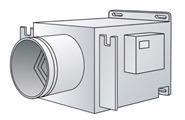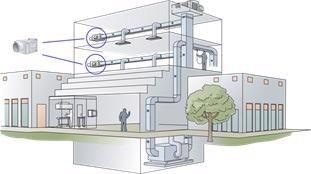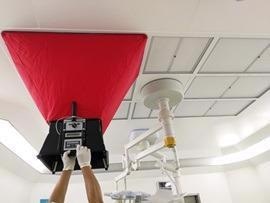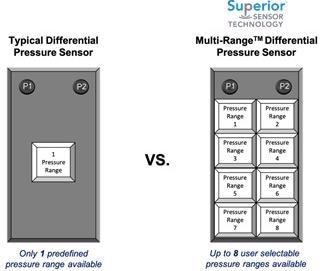Variable Air Volume (VAV) is a type of HVAC system that preserves a constant temperature while fluctuating the airflow intensity to heat or cool buildings. This is contrary to the way Constant Air Volume (CAV) systems work; CAV systems supply a constant airflow while the temperature of air changes.

Image Credit: Superior Sensor Technology
The below example shows how such a VAV system works.
An air handling unit drives air into the HVAC duct system at a constant temperature, for instance, at 13 °C. This air temperature remains constant throughout the HVAC system, moving through each zone of the building’s ductwork.
As the air passes through each zone, it flows across a VAV box or terminal, which varies the airflow into the zone in accordance with the thermostat setting of that area.
In addition to a damper that changes to regulate airflow, most VAV boxes also contain a heating element for warming the air as necessary.
According to the requirements of each specific zone, the VAV terminal modulates temperature. This enables more efficient control as the HVAC system provides various temperatures and fan speeds throughout the system to meet the needs of the individual zones. The added control of VAVs offers a number of extremely important benefits:
- More precise temperature control: In contrast to a CAV system that runs the fan and compressor at full capacity in an on/off cycle, a VAV system consistently varies the fan speed to sustain a constant air temperature.
- Reduced compressor wear: As a VAV system modulates the control of the compressor, its wear and tear is reduced over the long term.
- Lower energy consumption by system fans: VAV fan control, particularly with electronic variable speed drives, leads to an energy consumption reduction which is a significant part of the total cooling energy costs of a building.
- Less fan noise: CAV systems run fans at maximum speed and turn them on/off constantly, resulting in considerable noise compared to a VAV system that runs at a more constant, lower speed fan at a reduced decibel level that can easily blend into the background.
- Increased dehumidification: The air is dehumidified as the VAV system exposes air to cooling coils longer than CAV systems, with more moisture condensing on the coils.

Figure 1. HVAC Implementation with VAV Terminals. Image Credit: Superior Sensor Technology
The Role of Differential Pressure Sensors in VAV
As VAV systems are able to sustain a constant temperature and vary the airflow to reach the desired conditions, differential pressure sensors play a central role in their function.
In particular, the sensors are able to measure the volume of air across two points and supply the control system with appropriate feedback to open or close dampers to preserve the temperature required in each of its zones.

Figure 2. VAV Airflow Test. Image Credit: Superior Sensor Technology
While differential pressure sensors are a key component of VAV systems, they are vulnerable to external factors that can influence performance.
For instance, fans and blowers produce significant amounts of noise and vibrations that can affect the sensor’s accuracy. Filtering out that noise prior to it reaching the sensing element will significantly improve accuracy.
A crucial consideration to bear in mind when installing sensors in a complex system is the necessity to maintain long-term stability, as replacing sensors or VAV units is labor-intensive and can be expensive, particularly in larger HVAC implementations.
Finally, as the different zones of the ‘air network’ may have varying requirements (e.g., an interior lab or server room vs. a window facing conference room), the capability to have one differential pressure sensor that can fulfill all the different pressure requirements will streamline the overall system design and simplify VAV device inventory management.
Superior Sensor’s Technology Advantages in VAV
Superior Sensors’ proprietary NimbleSenseTM architecture is an industry-first System-in-a-Sensor integrated platform.
Combining a highly differentiated state-of-the-art pressure sensing system with the capability to integrate optional building blocks facilitates application-exclusive features while delivering the highest levels of accuracy and reliability.
With specialized technology deployed in Superior Sensor’s HV Series of differential pressure sensors, Superior’s products provide a number of advantages for VAV terminals.
Excellent Long-Term Stability
Long-term stability is determined by the maximum change in zero signal and output span signal of a pressure sensor under reference conditions in one year. This value is of utmost importance in low-pressure ranges as the effect on the signal is stronger.
Factors such as temperature and mechanical stress can negatively impact long-term stability. Based on Superior Sensor’s implementation, the HV Series has market-leading long-term stability measured around 0.15% of FSS within the first year.
Highest Levels of Accuracy
Sensor accuracy is of vital importance when measuring the responsiveness of HVAC systems. Superior’s HV Series of differential pressure sensors have the greatest accuracy throughout the industry: by and large within 0.05% of the selected pressure range and a total error band (TEB) generally within 0.15% of FSS.
Lowest Noise Floor
External noise from blowers, fans and other sources can negatively impact the accuracy and long-term stability of differential pressure sensing systems.
Utilizing Superior’s integrated advanced digital filtering technology, these pressure sensors cancel out the noise each of these factors creates before they reach the sensor sub-system. By canceling out the noise before it becomes an error signal, Superior delivers the industry’s lowest noise floor.
Multi-RangeTM Technology
Multi-Range technology means that several different sensors can be replaced by just one sensor.
On the HV Series, one device with Multi-Range can support up to 8 different pressure ranges with each pressure range optimized and factory calibrated to make sure no degradation occurs in total error band, accuracy or long-term stability irrespective of the range selected.
Figure 3 presents the difference between a conventional differential pressure sensor and Superior Sensor’s HV Series.

Figure 3. HV Series Multi-Range Technology Comparison. Image Credit: Superior Sensor Technology
With Multi-Range, manufacturers can offer one VAV terminal with up to 8 pressure range options that can be set with a single software command.
This facilitates the implementation of the same box throughout the building’s HVAC network, and each box can be easily configured at installation.
There is no need to purchase different VAV terminals for different zones, as the same terminal can be used throughout — the larger the HVAC system, the more advantages gained from using Multi-Range technology.
Conclusion
HVAC systems significantly benefit from the implementation of VAV systems as they are energy efficient and more accurate. A key component of VAV boxes is differential pressure sensors that consistently measure the airflow and direct the control system to make adjustments as necessary.
Superior Sensor’s special differential pressure sensor technology, based on proprietary NimbleSense architecture, offers a number of benefits for VAV systems such as exceptional long-term stability, greater accuracy and the capability to utilize the same VAV box throughout your network and configure each throughout implementation.
For more information on Superior Sensor’s solutions, visit the HV Series product page or contact the company directly.

This information has been sourced, reviewed and adapted from materials provided by Superior Sensor Technology.
For more information on this source, please visit Superior Sensor Technology.